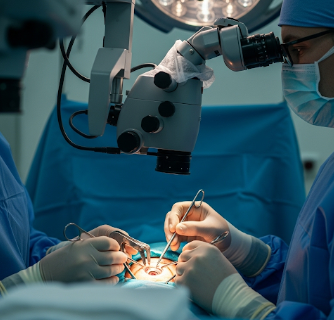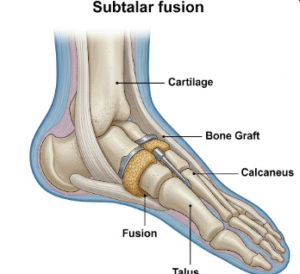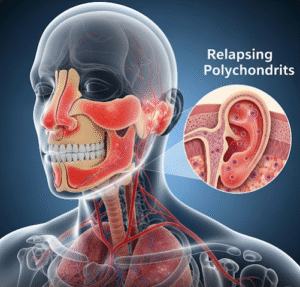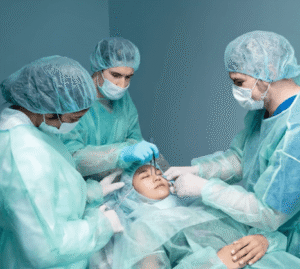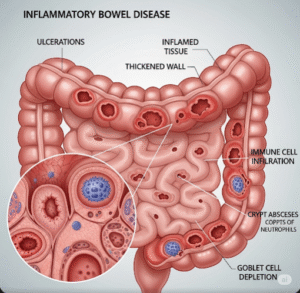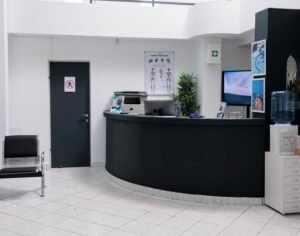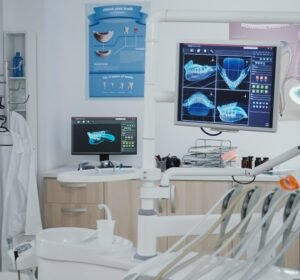Overview
Cataract surgery is a medical procedure to remove a cloudy lens from the eye and replace it with an artificial intraocular lens (IOL). Cataracts cause vision impairment, glare, and decreased quality of life, and surgery is the most effective treatment to restore clear vision.
Importance of cataract surgery:
- Restores clear, sharp vision.
- Improves daily functioning and quality of life.
- Reduces risk of falls and accidents caused by poor vision.
- Enhances independence in older adults.
In South Korea, cataract surgery is widely available in advanced ophthalmology centers and hospitals, using state-of-the-art technology such as phacoemulsification, femtosecond laser-assisted cataract surgery, and premium intraocular lenses.
Why It’s Done
Cataract surgery is performed to remove vision-impairing cataracts and improve visual function.
Common indications include:
- ➤ Blurry or cloudy vision interfering with daily activities.
- ➤ Difficulty seeing at night or glare from lights.
- ➤ Double vision or color fading due to lens opacity.
- ➤ Cataract-related eye complications: Secondary glaucoma or lens-induced inflammation.
- ➤ Impact on lifestyle and work: When cataracts prevent normal functioning.
Benefits for patients:
- ✔️ Restores sharp and clear vision.
- ✔️ Reduces dependency on glasses or visual aids in some cases.
- ✔️ Enhances safety in mobility and daily activities.
- ✔️ Improves quality of life and independence.
Alternatives
While surgery is the definitive treatment, some alternatives or temporary measures exist:
- ➤ Prescription glasses or stronger lenses: May help temporarily in early-stage cataracts.
- ➤ Magnifying lenses or visual aids: Useful for reading or close work.
- ➤ Lifestyle adjustments: Increased lighting, avoiding glare, or limiting night driving.
Key point: Non-surgical options do not stop cataract progression. Surgery is required for permanent visual restoration.
Preparation
Preparation for cataract surgery involves eye assessment and preoperative planning.
Steps include:
- ✅ Comprehensive eye examination: Visual acuity, slit-lamp evaluation, intraocular pressure measurement.
- ✅ Biometry: Measuring eye dimensions to select the correct intraocular lens (IOL).
- ✅ Medical evaluation: Review systemic conditions such as diabetes or hypertension.
- ✅ Medication review: Adjust anticoagulants or medications affecting surgery.
- ✅ Consent and counseling: Explain procedure, risks, recovery, and visual expectations.
- ✅ Preoperative instructions: Use prescribed eye drops to prevent infection and inflammation.
Important: Proper preparation ensures accurate lens selection and reduces surgical complications.
How It’s Done
Cataract surgery is typically performed under local anesthesia with mild sedation, using microsurgical techniques.
Step-by-step process:
- Anesthesia: Eye is numbed with drops or injection; patient remains awake.
- Incision: Tiny incision (~2–3 mm) made at the edge of the cornea.
- Lens removal:
- Phacoemulsification: Ultrasound breaks up the cloudy lens, which is suctioned out.
- Alternative techniques: Extracapsular or intracapsular cataract extraction for complex cases.
- IOL implantation: Artificial lens placed in the natural lens capsule.
- Incision closure: Often self-sealing; rarely requires sutures.
- Postoperative care: Eye shield or patch applied temporarily; protective measures explained.
Duration: 15–30 minutes per eye for standard phacoemulsification.
Hospital stay: Usually outpatient; patient goes home the same day.
Key point: Modern techniques are minimally invasive, precise, and highly effective.
Recovery
Recovery after cataract surgery involves gradual improvement of vision and healing of the eye.
Immediate post-op:
- Mild discomfort, itching, or tearing may occur.
- Eye drops prescribed for infection prevention and inflammation control.
- Protective eye shield advised during sleep or exposure to dust.
Short-term recovery:
- Avoid rubbing the eye or strenuous activity for 1–2 weeks.
- Vision may fluctuate; gradual improvement over days to weeks.
- Follow-up visits to monitor healing and eye pressure.
Long-term recovery:
- Full vision stabilization occurs in 4–6 weeks.
- Most patients resume normal activities within a few days.
- Premium IOLs may reduce dependence on glasses for distance or near vision.
Important: Strict adherence to post-op instructions and medication regimen ensures optimal results.
Possible Complications
Cataract surgery is generally safe and effective, but complications can occur:
- ⚠️ Infection (endophthalmitis) – rare but serious.
- ⚠️ Inflammation – controlled with eye drops.
- ⚠️ Posterior capsular opacification – “secondary cataract” may require laser treatment.
- ⚠️ Intraocular lens dislocation – rare, may require repositioning.
- ⚠️ Glaucoma or increased eye pressure – monitored postoperatively.
- ⚠️ Retinal detachment – rare, more common in high myopia.
- ⚠️ Vision changes or double vision – usually temporary.
In South Korea, advanced surgical techniques, sterilization protocols, and postoperative monitoring minimize complications and ensure high success rates.
Treatment Options / Clinical Relevance in Korea
Cataract surgery in South Korea is performed in state-of-the-art ophthalmology centers with high success and patient satisfaction.
Key features:
- 🏥 Phacoemulsification and femtosecond laser-assisted surgery widely available.
- 🏥 Premium intraocular lenses for presbyopia or astigmatism correction.
- 🏥 Outpatient surgery model for convenience and reduced hospital stay.
- 🏥 Advanced preoperative imaging and biometry for precise lens selection.
- 🏥 Integrated postoperative care and follow-up ensure excellent visual outcomes.
Hospitals offering cataract surgery in Korea:
- Seoul National University Hospital – Advanced ophthalmology and cataract surgery
- Asan Medical Center – Femtosecond laser-assisted cataract surgery and IOL implantation
- Samsung Medical Center – Comprehensive eye care and surgery
- CHA Bundang Medical Center – Premium IOLs and minimally invasive cataract surgery
Highlights in Korea:
- ✔️ High precision surgery with modern microsurgical techniques.
- ✔️ Short recovery time with outpatient procedures.
- ✔️ Advanced lens options reduce dependence on glasses or contact lenses.
- ✔️ Postoperative care ensures excellent vision restoration and minimal complications.
Highlights
- ➤ Cataract surgery removes cloudy lenses and restores clear vision.
- ➤ Indicated for vision impairment affecting daily activities or causing complications.
- ➤ Alternatives include glasses, magnifying aids, or lifestyle adjustments, but surgery is definitive.
- ➤ Preparation involves eye exams, biometry, medical evaluation, and pre-op drops.
- ➤ Procedure duration: 15–30 minutes per eye under local anesthesia; outpatient surgery.
- ➤ Recovery includes eye drops, protective measures, and gradual vision improvement over weeks.
- ➤ South Korea provides advanced cataract surgery, with premium lenses, laser-assisted techniques, and comprehensive postoperative care.

